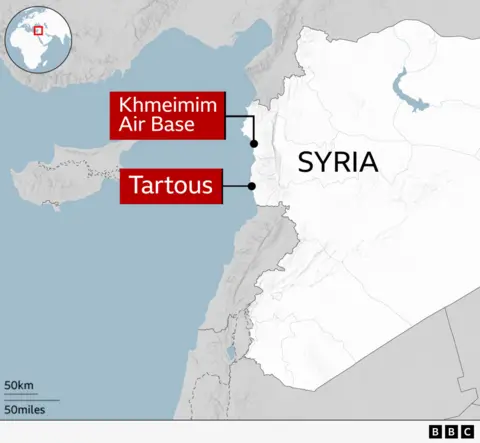Russian ships leave Syria base amid doubts about future

 getty images
getty imagesAmid continuing uncertainty about Moscow’s military future in the country following the fall of its ally Bashar al-Assad, satellite images reviewed by BBC Verify show that Russian naval vessels have temporarily closed their main port in Syria. Have left.
Photos taken by Maxar on December 10 show that some of the ships have left the Tartus naval base since Sunday and are currently sitting off the coast in the Mediterranean Sea.
Meanwhile, other photos taken the same day show continued activity at Russia’s main airbase in Khmeimim in Syria, with jet aircraft clearly visible.
On Monday, Kremlin spokesman Dmitry Peskov said Moscow would hold talks with incoming officials about Russia’s future military presence.
“Every possible effort is now being made to contact those involved in ensuring security and, of course, our military is also taking all necessary precautions,” he told reporters in Moscow.
He previously warned that it would be “premature” to speculate on the future of the bases.
“You know that, of course, we maintain contacts with those who now control the situation in Syria. This is necessary because we have bases there and our diplomatic offices (embassies). And of course “Ensuring the safety of our facilities is of utmost importance,” he told reporters.
The Tartus naval facility consists of elements of the Black Sea Fleet and is Russia’s only repair and replenishment center in the Mediterranean. Established by the Soviet Union in the 1970s, it was expanded and modernized by Russia in 2012 as the Kremlin began increasing its support for President Assad’s regime.
This allows Russian ships to remain in the Mediterranean without returning to ports in the Black Sea through the Turkish Straits. According to the US Naval Institute, it is also a deep-water port, meaning it can host submarines from Moscow’s nuclear fleet.
New satellite images show Moscow has at least temporarily brought its ships out of port, with two guided missile frigates docked about 13 kilometers (eight miles) off the Syrian coast. It is unclear where the remainder of the fleet – depicted in earlier images – is currently located.
It is also unclear whether his departure is part of a permanent withdrawal from Tartus. In recent weeks, satellite images have repeatedly shown naval vessels arriving and departing from the port.
Mike Plunkett of the Jane’s Organization of Open-Source Defense Intelligence Analysts said it appeared that Russian activities were “done to ensure that their ships are not vulnerable to attack”.
“Whether they are concerned about an attack by Syrian rebels or about damage caused by an Israeli attack on Syrian property in Tartus is unknown,” he said.

Former Belgian navy captain and analyst Frederic Van Lokeren told BBC Verify that it appeared Russian ships were now in a holding pattern while Moscow deliberated on its next move.
“They’re effectively in limbo at the moment because they don’t know what’s going to happen,” Mr Van Lokeren said.
“Apparently, since they are staying there, it seems that Russia is not yet ready to withdraw all of its naval vessels from the area, which could be an indication that they are negotiating with regional partners so that “To see where they can redeploy these ships.”
Analysts have speculated that if Russia is forced to close the Tartus naval facility, it may redeploy its presence to Tobruk in Libya. The region is controlled by Kremlin-backed Field Marshal Khalifa Haftar and already hosts some Russian air bases.
But withdrawing from Tartus would be extremely costly, and Mr Van Lokeren said the move would bring Russian ships closer to NATO bases, making them easier to track. There is currently no indication that Russia is transferring the naval assets needed to remove equipment from Tartus, he said.
Meanwhile, since 2015 Khmeimim airport has become a key part of Russia’s operations in the Middle East and Africa. It has been used to launch devastating airstrikes on cities across Syria in support of the Assad regime, while it has also been used to blow up military contractors in Africa.
Satellite images reviewed by BBC Verify showed at least two large jets – which Janes identified as Il-76 transport aircraft – sitting on the tarmac at the base, also on 10 December. Helicopters can also be seen at the base in the pictures.
Janes also notes that air defense systems deployed at the site are visible in the northwest corner of the image.

Dara Massicotte, an analyst at the Carnegie Endowment for International Peace, said on Sunday that clearing the airbase would require a massive airlift, requiring far more jets than are visible in satellite images, This suggests Moscow is not planning an immediate evacuation. ,
“When Russian forces deployed to Syria in 2015, they flew about 300 sorties in two weeks, and that was before the base expansion,” he wrote on X.
“A change indicating a large withdrawal would be obvious,” he said.
Despite the current holding pattern displayed by Russian forces, the fall of the Assad regime represents a major blow to the Kremlin’s ambitions in the region. During a visit to Khmeimim Airport in 2017, President Vladimir Putin made clear that he intended to make Moscow’s presence a long-term project.
Reflecting on the situation, Rybar, an influential pro-Kremlin military blogger, warned on Telegram that Russia’s power-projection exercises in the region are in grave danger.
He concluded, “Russia’s military presence in the Middle East region is at risk.”

Additional reporting by Paul Kuciak. Graphics by Mark Edwards.







